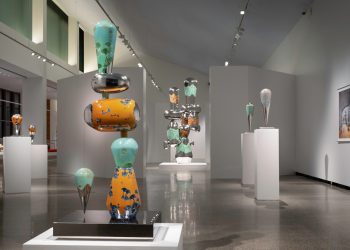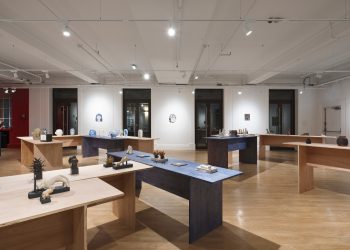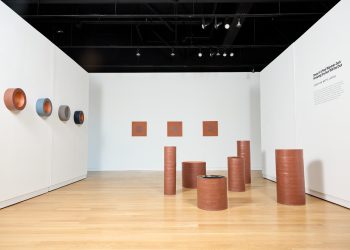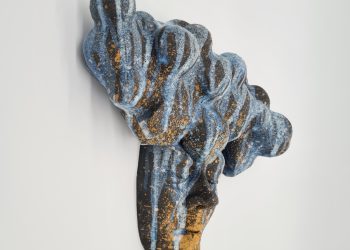By John Roloff
The project and related concepts presented in Expanded Ceramics/Holocene Agriculture are an extension of over 50 years of work in ceramics that view the materials and processes of ceramics in a geologic and environmental context. Originating from my studies under Robert Arneson and Eldridge Moores as an art/geology major at UC Davis in the late 1960’s, the materials of sculpture and ceramics are perceived from the viewpoint of natural origin, process, and scale. Dolomite, kaolin, feldspar, and other pulverized rock housed in the glaze room were derived from rock formations and functions of proceses studied as terrestrial/oceanic geologic structures, process and time. The environmental Land Kiln works, 1979-1992, employed the kiln as an alchemical instrument and mythic effigy in the landscape to explore earth materials in-situ, and the foundations of their origin in and of the earth. For Expanded Ceramics/Holocene Agriculture, the common agricultural plow as well as the practice of soil-based agriculture are considered in an interdisciplinary and ecological context of ceramics, earth sciences and soil sciences. The plow as an environmental ceramic tool along and furrow/planting dynamics/aesthetics engaged as instruments to explore the bio-nutrient potential of ceramic materials, their derivation and larger environmental, paleo-climatic, species migration and global metabolic implications.
Contents
I. Study: Expanded Ceramics: Plow Instrument With Ceramic Nutrient Mineral Distribution Device
II. Expanded Ceramics / Earth Reversal / Peat Extraction
Ceramics Department / University of Washington / Seattle, WA (John Roloff with Michael Swaine’s students / January 2017)
III. Site Study I: Expanded Ceramics / Museum Displacement / Natural/Agrarian Systems (Great Valley Complex)
Manetti Schrem Museum, Davis, CA, Concepts for NCECA 2022
IV. Site Study II: Expanded Ceramics / Museum Displacement / Natural/Agrarian Systems (Inversion) (Great Valley Complex)
Manetti Schrem Museum, Davis, CA, Concepts for NCECA 2022
V. Site Study III: Expanded Ceramics / Earth-Biome Ship Vectors / Anthropocene/Tertiary (Great Valley Complex)
Manetti Schrem Museum, Davis, CA, Concepts for NCECA 2022
Study: Expanded Ceramics: Plow as Instrument with Ceramic Nutrient Mineral Distribution Device
Ceramic glaze and clay body materials selected and formulated for their nutrient value according to site soil chemistry are added and tilled into the soil by plow systems of various configurations. ceramic materials of various mesh sizes such as: volcanic ash, dolomite, bone ash, silica, feldspars, clays, talc, wollastonite and others have known biotic nutrient value or potential. Specific glaze and clay-body formulas may be selected for poetic/nutrient and experimental combinations with existing soils, biomes and climates in contemporary, geologic or future times. The geochemical simulation of site-relevant, paleo-depositional systems and environments such as previous volcanic ash falls, paleo-fluvial, estuarine, pelagic, etc. environments, metamorphic or igneous relationships through the use and incorporation of ceramics glaze and clay body materials and formulas has generative potential for experimental and conceptual evolution of the kinship of ceramics to the landscape, climate change, paleo and future biotic systems and soil. The historical and contemporary language of ceramic implements, plates, bowls, etc., bricks, tiles, etc., is expanded into agricultural and global metabolic dimensions by expanding the systemic definition, origin and implementation of ceramics. The preferred use of horse-drawn plows and implements, when practical, is analogous to the potter and kick-wheel, a focused, sensitive and slower approach to material, site, systemic and object relationships, locally and globally.
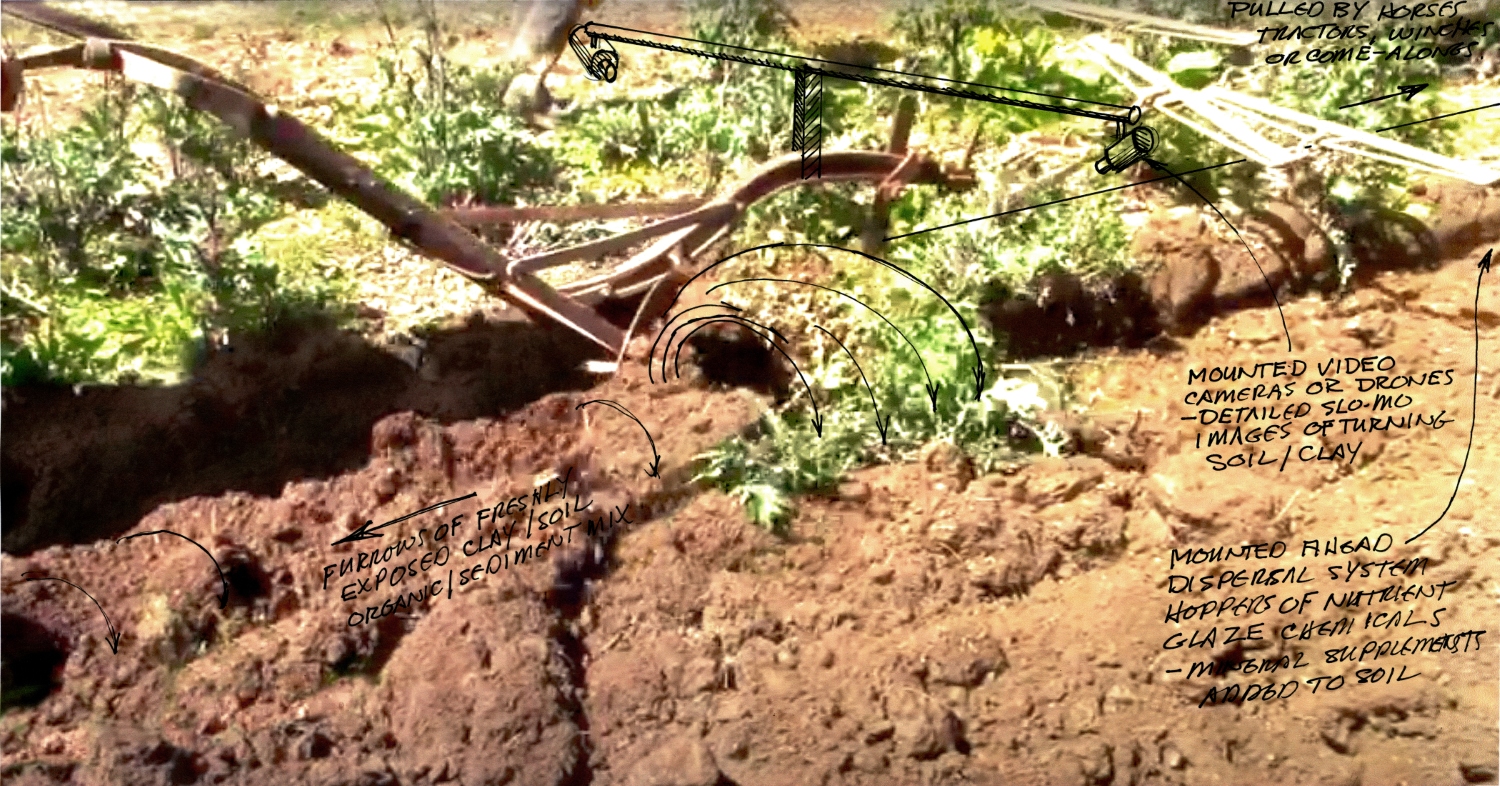
Plow / Documentation Study: The intimacy of a simple implement engaging with the landscape, considered as a clay tool, connects ceramics with larger, also intimate, relationships of natural systems and human and global metabolism. Video documentation of the soil/implement interface at normal and slower speeds, an opportunity for visual and media propagation of the inherent poetics of plowing, in the context of Expanded Ceramics.
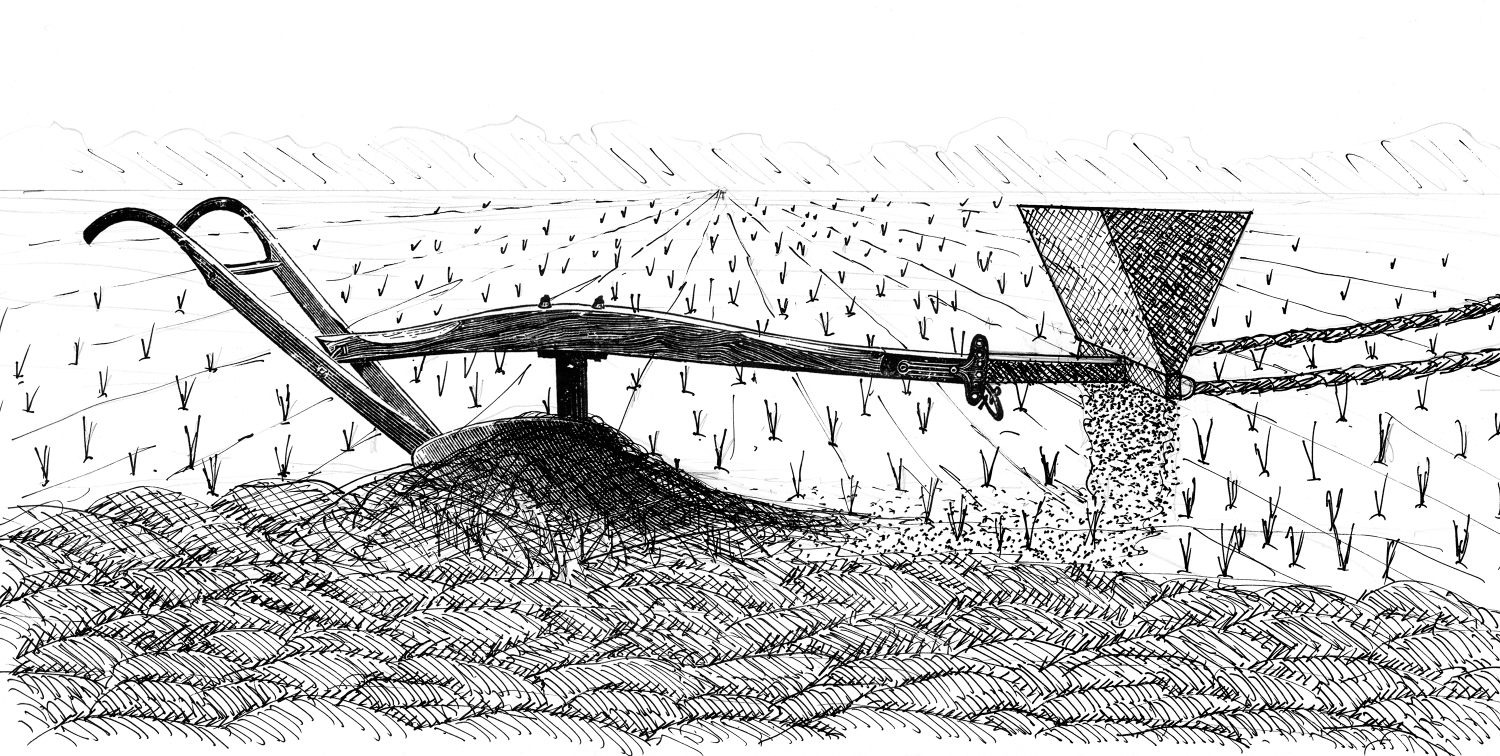
Expanded Ceramics / Earth Reversal / Peat Extraction
Ceramics Department / University of Washington / Seattle, WA (John Roloff with Michael Swaine’s students / 1/20/2017)
A geologic site study of the University of Washington Ceramics facility site revealed two available Quaternary, surficial, strata for physical investigation. The motorized tiller and auger used for this project are seen as clay tools performing in the context of an expanded definition of ceramics that includes: agriculture, geology and the landscape. Two strata were within reach of the project, the uppermost an approximately 1 meter deep Holocene deposit of Lake Washington peat overlying 1 to 10 meter Pleistocene glacial tills left by receding glaciers. The work performed on site included a Tiller component, two phases of a ‘Mineral Scatter’ component and a ‘Post Hole Auger/Brick Displacement’ component. A preliminary video edit of the project and sediment bricks described below were used in the exhibition, Diderot/Forrest/Roloff at NCECA 2017, Portland, OR. Long-term investigations of ceramics as a function of geologic materials and processes as well as inspiration from Diderot’s Encyclopedia were instrumental in the development of this project.
This project was a prototype of an experimental series of agricultural-related works which in optimum form the ‘Tiller’ component would use a traditional horse-drawn plow, which produces a more solid and sensual elongated clay/earthen form/furrow than the mechanical tiller, as well as other farm implements related to the ‘Post Hole Auger/Brick Displacement’ component. The ‘Mineral Scatter’ component is also part of a long-standing exploration, including the Land Kilns, into organic/inorganic material and process relationships.
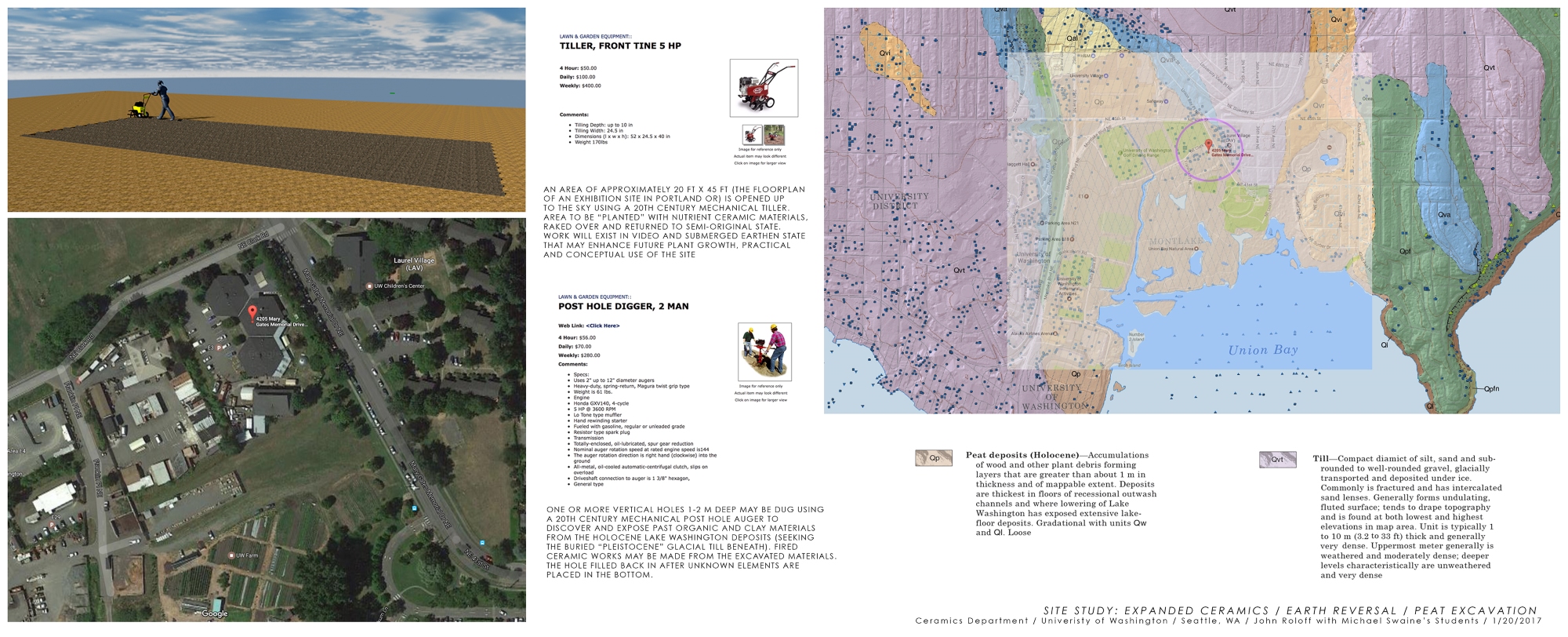
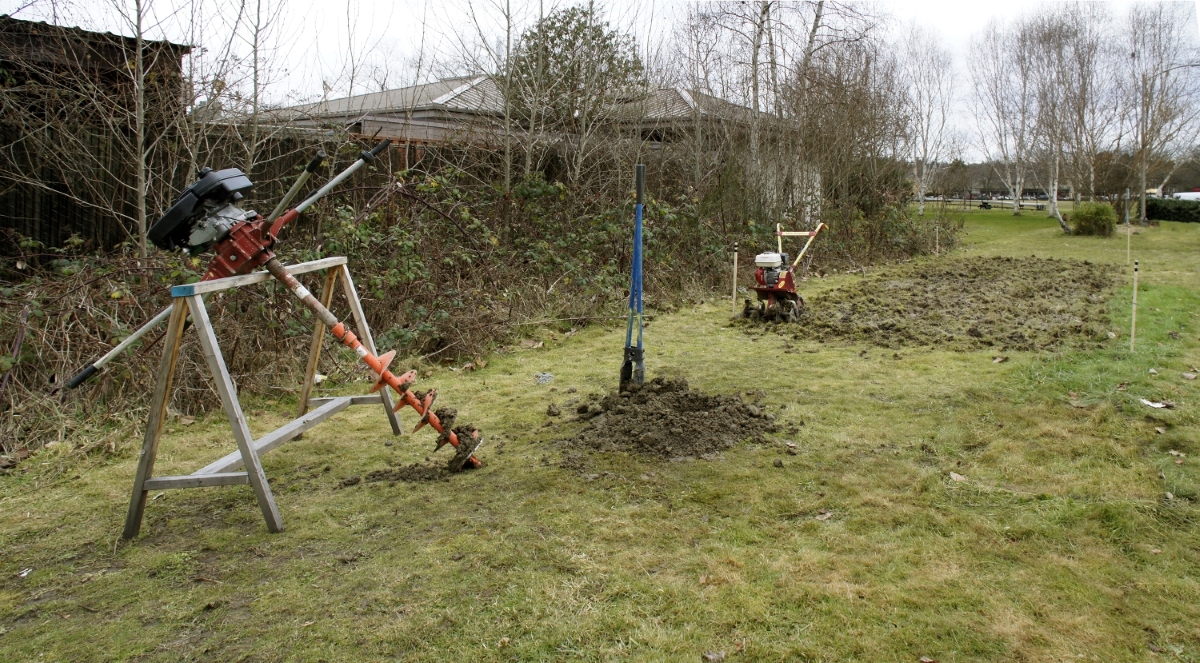
Tiller/Mineral Scatter:
For the project’s ‘Tiller Component,’ an area of approximately 20 ft. x 45 ft. (the floor plan of a portion of the 2017 NCECA exhibition site of Diderot/Forrest/Roloff, Portland OR) is opened up to the sky using a 20th century gasoline powered mechanical tiller. For Phase I and II of ‘Mineral Scatter Component,’ the area was “planted” with nutrient ceramic materials (Phase I – volcanic ash, dolomite and related minerals) and brick grog (Phase II) from the UW kilns crushed by UW ceramic students. The planted area was re-plowed with the same tiller to work the materials into the disturbed sediments. The project exists in submerged earthen state that may enhance future plant growth, practical and conceptual use of the site.
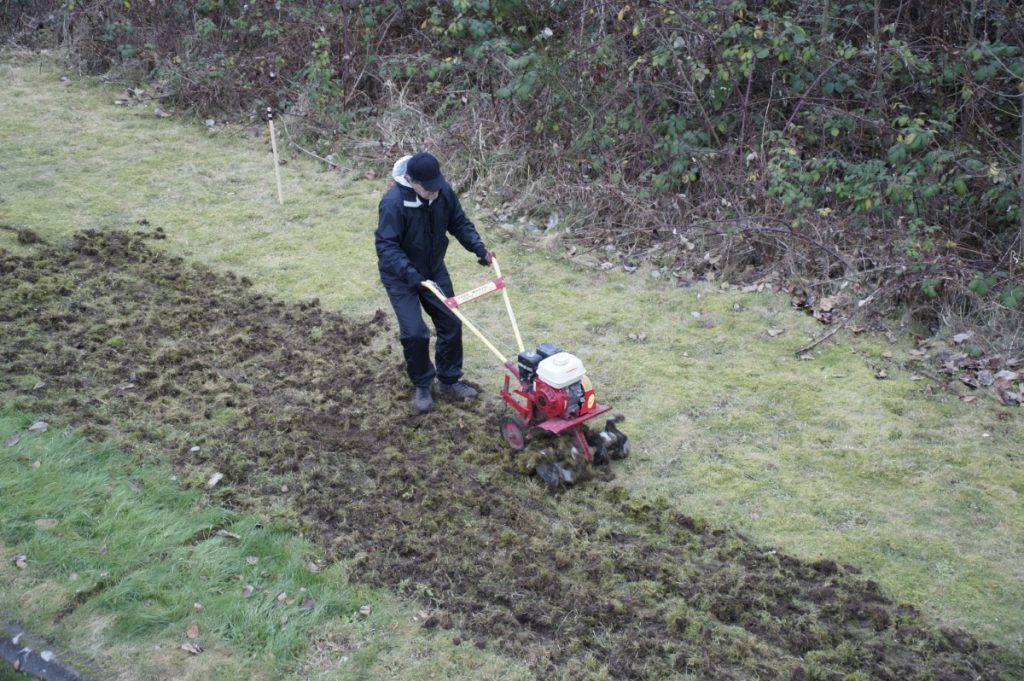
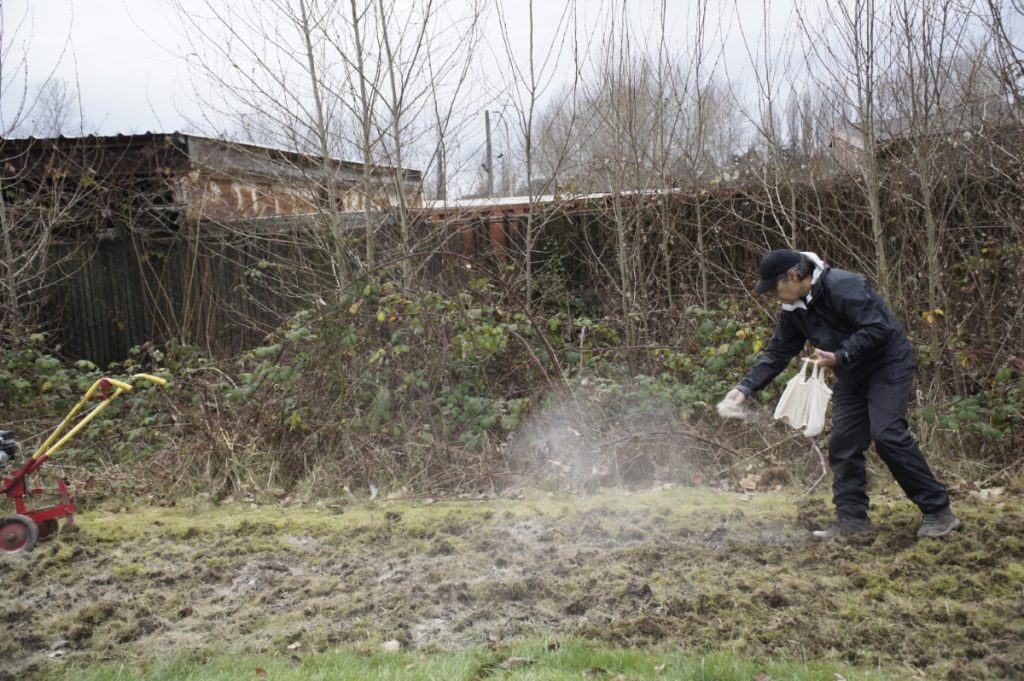
Post Hole Auger/Brick Displacement:
A single vertical hole 1.5 m deep was dug using a 20th century mechanical post hole auger to discover and expose past organic and clay materials From the Holocene Lake Washington deposits (seeking the buried Pleistocene glacial till beneath). Fired ceramic bricks were made from some of the excavated sedimentary materials, the auger cavity was displaced with used kiln bricks from the UW kilns mixed with the remaining excavated sediments. The fired sediment bricks were used as counterweights and site markers in the installation of Diderot/Forrest/Roloff.
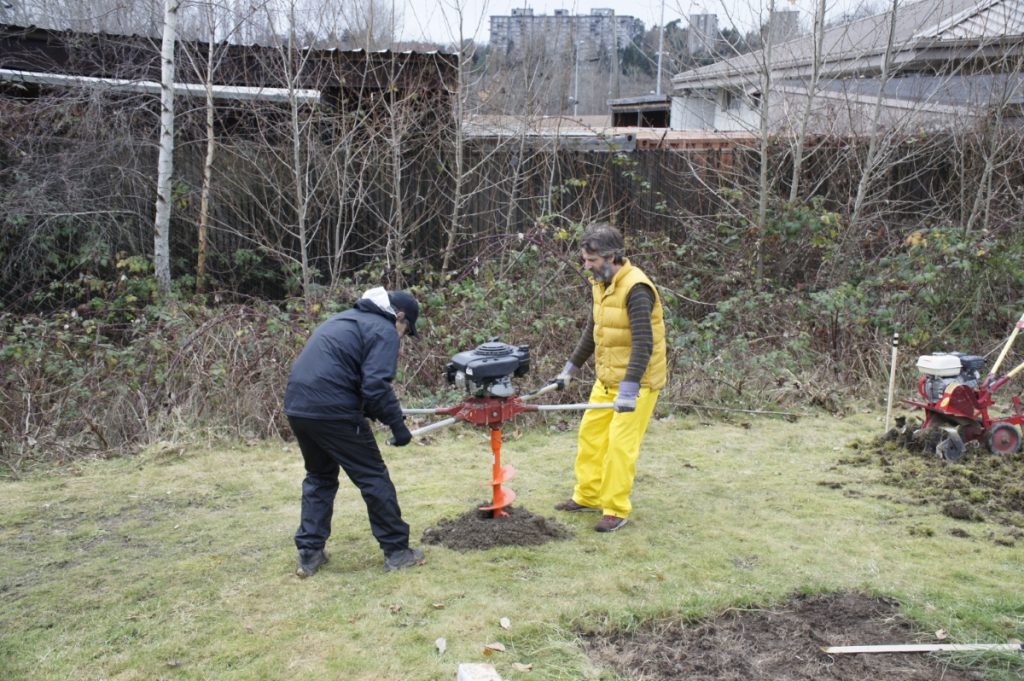
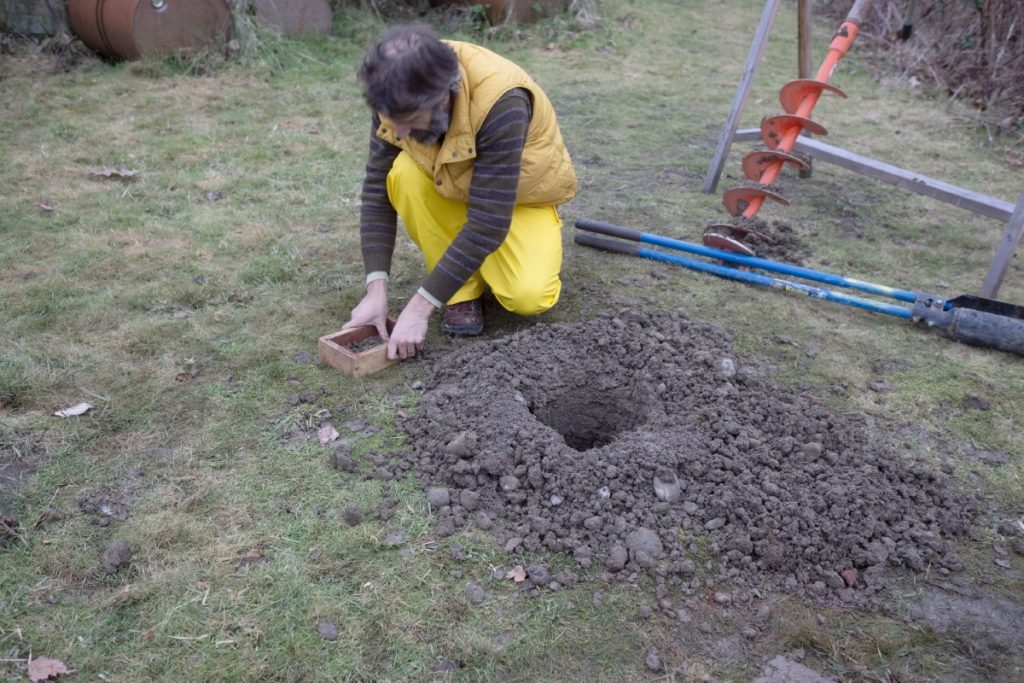
Expanded Ceramics / Interdisciplinary Agriculture / Earth Science / Art Department Concepts
Conceptual Proposals for NCECA 2022, Manetti Schrem Museum, Davis, CA 2021
These three concepts presented as proposal diagrams, extend Site Study: Expanded Ceramics/Earth Reversal/Peat Excavation, University of Washington project, 2017, by further investigating the use of the farmer’s plow as a ceramic tool, and ceramic materials in a metabolic, expanded ceramics, interdisciplinary, inter-departmental context. These proposals are centered at the Manetti Schrem Museum at UC Davis, the site of TB9, the ceramic art facility developed by Bob Arneson in the 1960’s, the School of Agriculture and School of Earth Sciences. The following concepts and included research, propose to work with Agricultural science, the Earth sciences and the Art Department at Davis in an interdisciplinary series of projects that spans those disciplines in an aesthetic, geo-chronological, geo-metabolic context. These concepts are part of a larger project, Great Valley Complex (UC Davis: Nodal Point / Great Valley Meta-frame) presents selected art concepts and projects that suggest a ‘meta-frame’ for the Great Valley of California. UC Davis, Davis, CA, as a site prominent in the artist’s development as an artist and is centrally situated within the Great Valley in Holocene/Anthropocene time – a nodal point from which to experiment, investigate and re-imagine systems of perception and knowledge of the greater Great Valley as a site of global metabolism, expanded ceramics and change in an interdisciplinary context.
Site Study I: Expanded Ceramics / Museum Displacement / Natural/Agrarian Systems (Great Valley Complex)
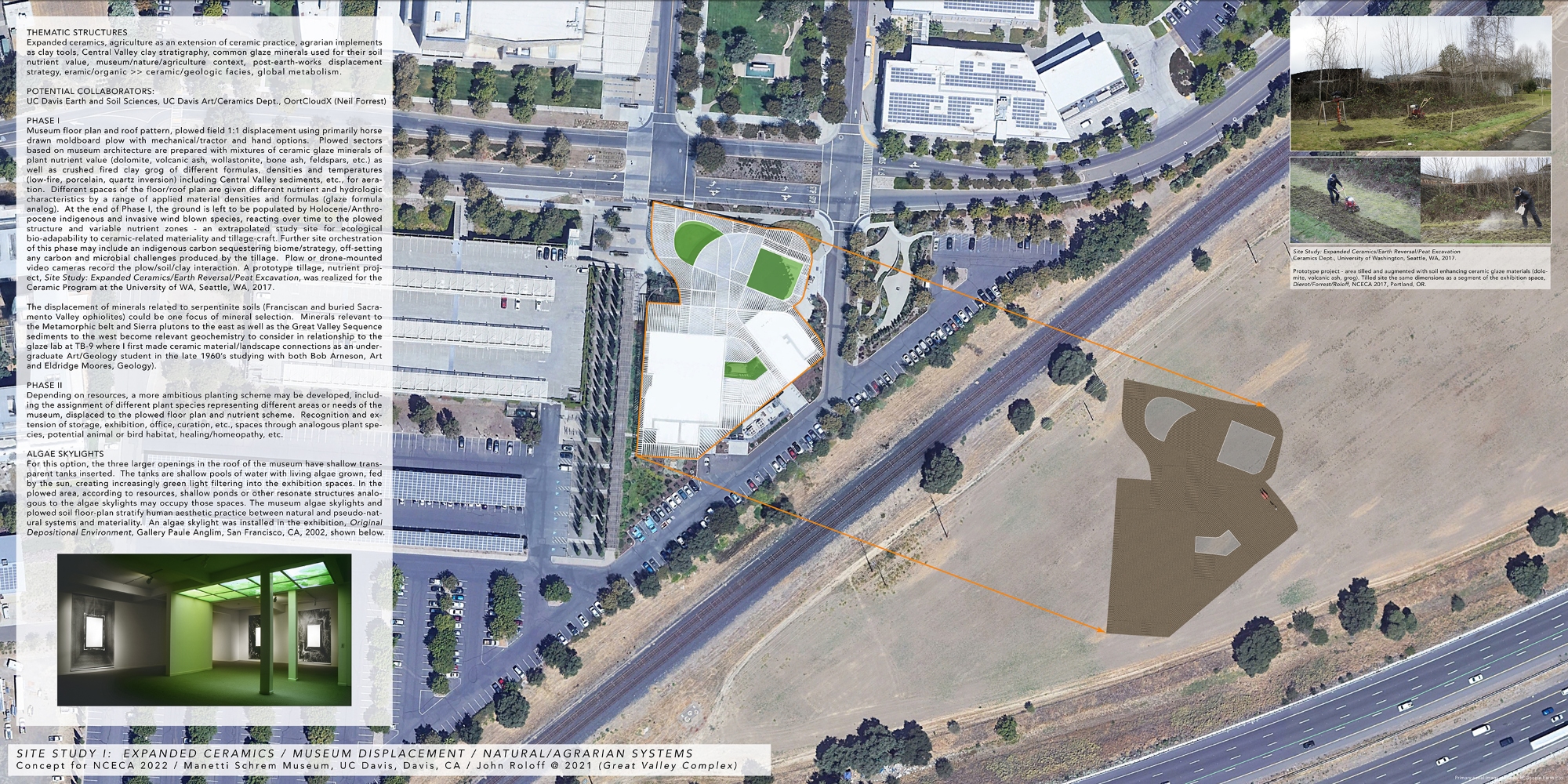
THEMATIC STRUCTURES:
Expanded ceramics, agriculture as an extension of ceramic practice, agrarian implements as clay tools, Central Valley clay stratigraphy, common glaze minerals used for their soil nutrient value, museum/nature/agriculture context.
POTENTIAL COLLABORATORS:
UC Davis Earth and Soil Sciences, UC Davis Art/Ceramics Dept., OortCloudX (Neil Forrest)
PHASE I
Museum floor plan and roof pattern, plowed field 1:1 displacement using primarily horse drawn moldboard plow with mechanical/tractor and hand options. Areas for plowing prepared with layers/sectors of mixtures of plant nutrient ceramic glaze minerals (dolomite, volcanic ash, wollastonite, bone ash, feldspars, etc.) and crushed fired clay grog for aeration. Different spaces of the floor plan are given different nutrient and hydrologic characteristics by a range of applied material densities and formulas (glaze formula analog). At the end of plowing, the ground for Phase I is left to be populated by Holocene/Anthropocene indigenous and invasive wind blown species, reacting over time to the plowed structure and variable nutrient zones – a museum extrapolated study site for ecological bio-adaptability to ceramic-related materiality and tillage-craft. Plow or drone-mounted video cameras record the plow/soil/clay interaction. A prototype project, Site Study: Expanded Ceramics/Earth Reversal/Peat Excavation, was realized for the Ceramic Program at the University of WA, Seattle, WA, 2017.
The displacement of minerals related to serpentinite soils (Franciscan and buried Sacramento Valley ophiolites) could be one focus of mineral selection. Minerals relevant to the Metamorphic belt and Sierra plutons to the east as well as the Great Valley Sequence sediments to the west become relevant geochemistry to consider in relationship to the glaze lab at TB-9 (where I first made the glaze/landscape connection as an undergraduate Art/Geology student in the late 1960’s as a student of Bob Arneson and Eldridge Moores in their respective fields of study).
PHASE II
Depending on resources, a planting scheme may be developed, based upon amended soil nutrients and the assignment of different plant species representing different areas of the museum, displaced to the plowed floor plan. Recognition of storage, exhibition, office, etc., spaces through analogous plant species, potential animal or bird habitat, etc.
PHASE II (ALGAE SKYLIGHTS)
For this option, the three larger openings in the roof of the museum have shallow transparent tanks inserted. The tanks are shallow pools of water with living algae grown, fed by the sun, creating increasingly green light filtering into the exhibition spaces. In the plowed area, according to resources, shallow ponds or other resonate structures analogous to the algae skylights may occupy those spaces. The museum algae skylights and plowed soil floor-plan stratify human aesthetic practice between natural and pseudo-natural systems and materiality. An algae skylight was installed in the exhibition, Original Depositional Environment, Gallery Paule Anglim, San Francisco, CA, 2002.
Site Study II: Expanded Ceramics / Museum Displacement / Natural/Agrarian Systems (Inversion) / (Great Valley Complex)
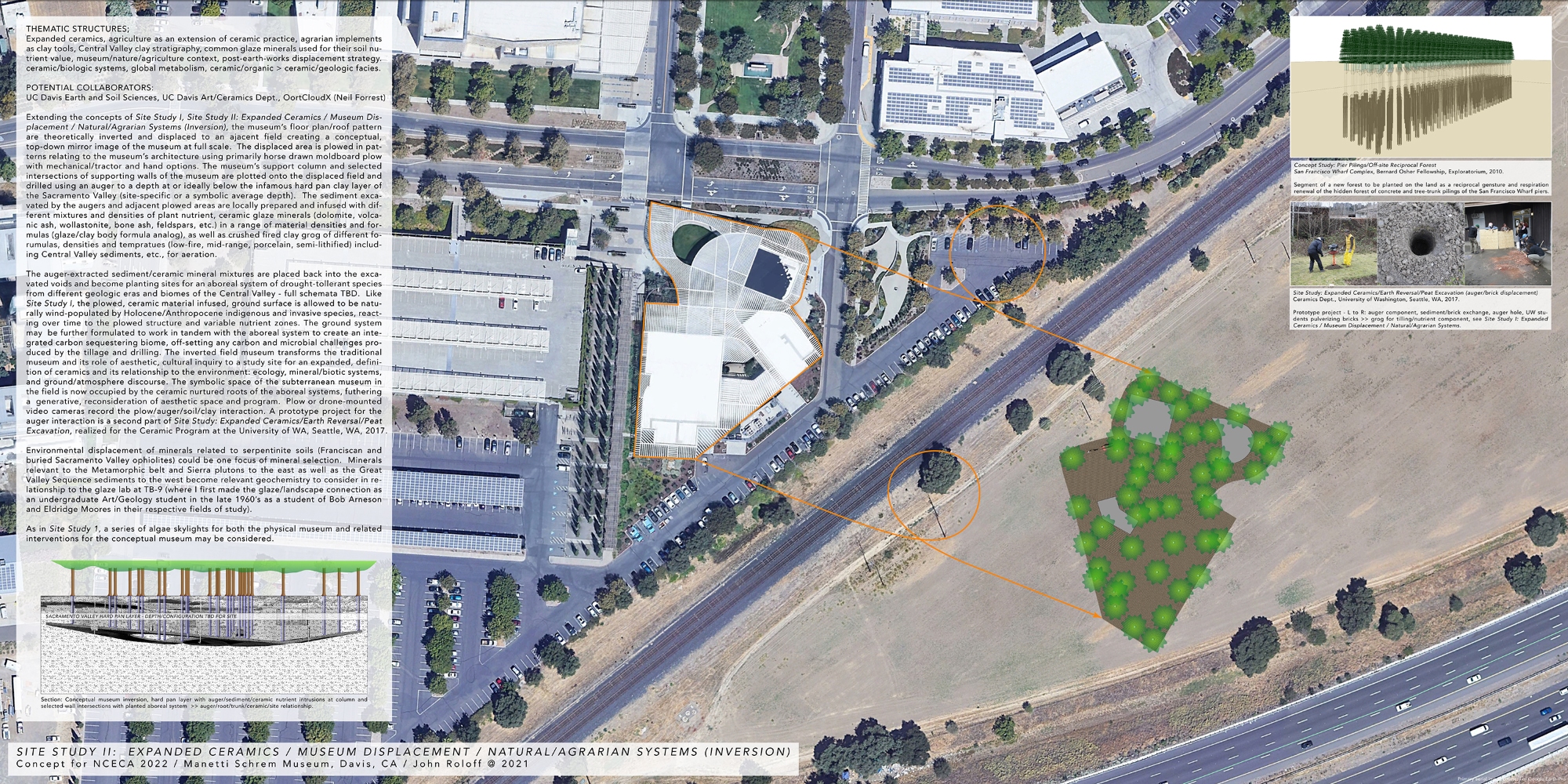
THEMATIC STRUCTURES:
Expanded ceramics, agriculture as an extension of ceramic practice, agrarian implements as clay tools, Central Valley clay stratigraphy, common glaze minerals used for their soil nutrient value, museum/nature/agriculture context.
POTENTIAL COLLABORATORS:
UC Davis Earth and Soil Sciences, UC Davis Art/Ceramics Dept., OortCloudX (Neil Forrest)
PHASE I
Museum floor plan and roof pattern, plowed field 1:1 displacement using primarily horse drawn moldboard plow with mechanical/tractor and hand options. Areas for plowing prepared with layers/sectors of mixtures of plant nutrient ceramic glaze minerals (dolomite, volcanic ash, wollastonite, bone ash, feldspars, etc.) and crushed fired clay grog for aeration. Different spaces of the floor plan are given different nutrient and hydrologic characteristics by a range of applied material densities and formulas (glaze formula analog). At the end of plowing, the ground for Phase I is left to be populated by Holocene/Anthropocene indigenous and invasive windblown species, reacting over time to the plowed structure and variable nutrient zones – a museum extrapolated study site for ecological bio-adaptability to ceramic-related materiality and tillage-craft. Plow or drone-mounted video cameras record the plow/soil/clay interaction. A prototype project, Site Study: Expanded Ceramics/Earth Reversal/Peat Excavation, was realized for the Ceramic Program at the University of WA, Seattle, WA, 2017.
The displacement of minerals related to serpentinite soils (Franciscan and buried Sacramento Valley ophiolites) could be one focus of mineral selection. Minerals relevant to the Metamorphic belt and Sierra plutons to the east as well as the Great Valley Sequence sediments to the west become relevant geochemistry to consider in relationship to the glaze lab at TB-9 (where I first made the glaze/landscape connection as an undergraduate Art/Geology student in the late 1960’s as a student of Bob Arneson and Eldridge Moores in their respective fields of study).
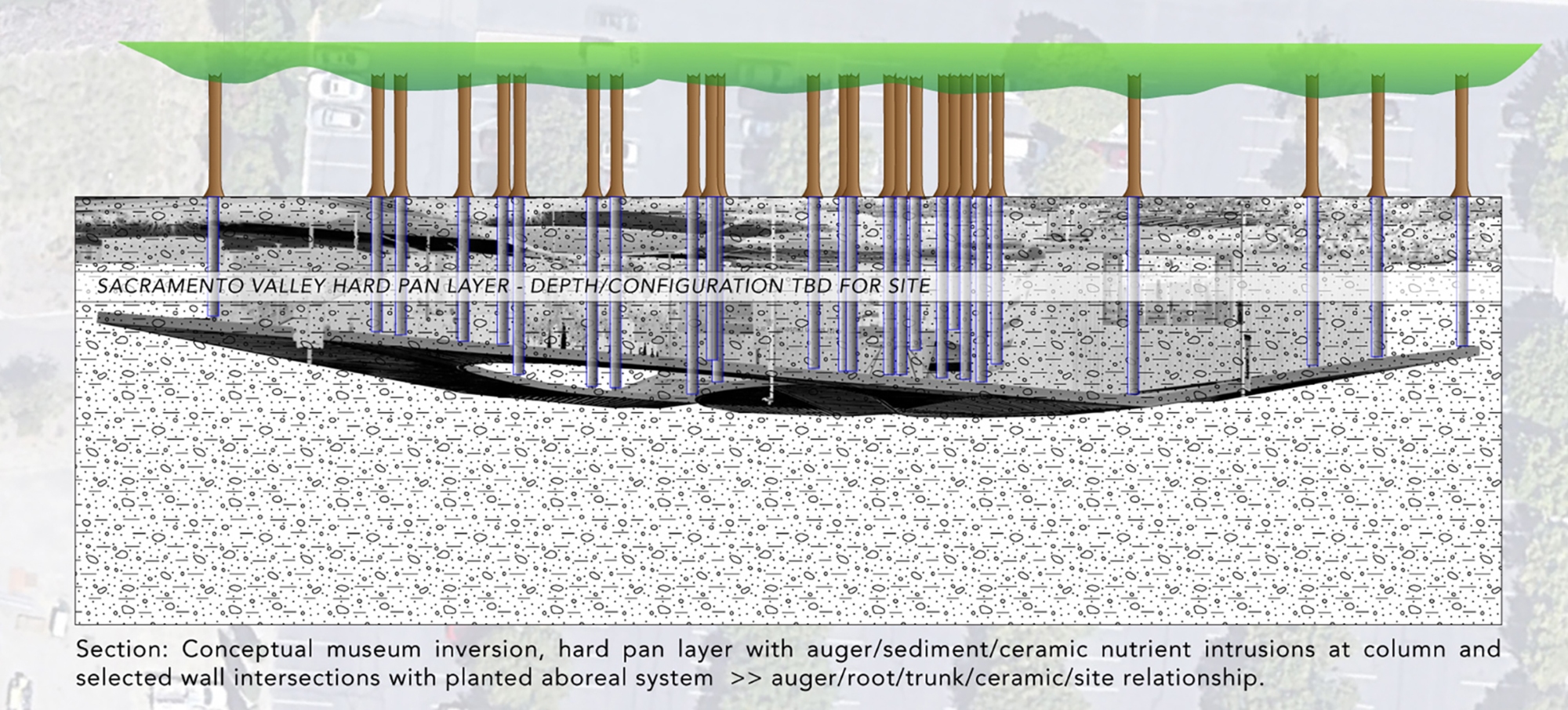
Site Study III: Expanded Ceramics / Earth-Biome Ship Vectors / Anthropocene/Tertiary (Great Valley Complex)
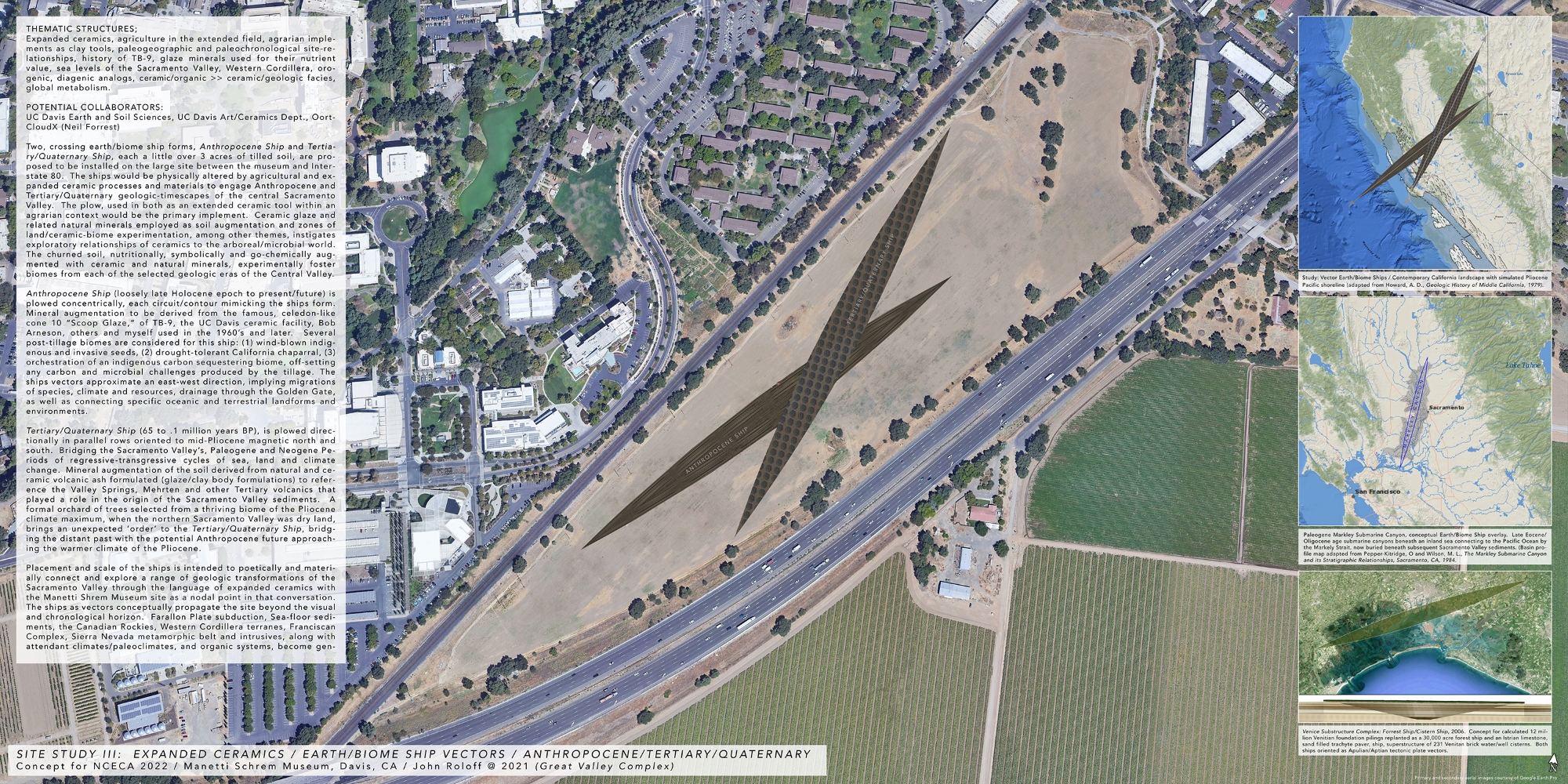
Concept for NCECA 2022 / Manetti Schrem Museum, Davis, CA / John Roloff 2021
THEMATIC STRUCTURES:
Expanded ceramics, agriculture in the extended field, agrarian implements as clay tools, hard-pan clay layer of Valley stratigraphy, common glaze minerals used for their nutrient value
POTENTIAL COLLABORATORS:
UC Davis Earth and Soil Sciences, UC Davis Art/Ceramics Dept., OortCloudX (Neil Forrest)
Two, crossing earth/biome ship forms, Anthropocene Ship and Tertiary/Quaternary Ship, each a little over 3 acres of tilled soil, are proposed to be installed on the large site between the museum and Highway 80. The ships would be physically altered by agricultural and expanded ceramic processes and materials to engage Anthropocene and Tertiary/Quaternary geologic-timescapes of the central Sacramento Valley. The plow in both an extended ceramic and agrarian context would be the primary tool, ceramic glaze and related natural minerals employed as soil augmentation and zones of land/ceramic-biome experimentation and argues for a relationship of ceramics to the arboreal/microbial world. The churned soil, nutritionally, symbolically and go-chemically augmented with ceramic and natural minerals, experimentally foster biomes from each of the selected geologic eras of the Central Valley.
The Anthropocene Ship (loosely late Holocene epoch to present/future) is plowed concentrically, each circuit/contour mimicking the ships form. Mineral augmentation to be derived from the famous, celadon-like cone 10 “Scoop Glaze,” of TB-9, the UC Davis ceramic facility, Bob Arneson and others used in the 1960’s and later. Several biomes are considered for this ship: (1) wind-blown indigenous and invasive seeds, (2) drought-tolerant California chaparral, (3) to be devised: orchestration of an indigenous carbon sequestering biome, off-setting any carbon and microbial challenges produced by the tillage. The ships vectors approximate an east-west direction, implying migrations of species, climate and resources, drainage through the Golden Gate, as well as connecting specific oceanic and terrestrial landforms and environments.
The Tertiary/Quaternary Ship (65 to .1 million years BP), is plowed directionally in parallel rows, magnetic north and south. Bridging the Central Valley’s, Paleogene and Neogene Periods, of transitions from sea to land, the mineral augmentation of the soil derived from natural and ceramic volcanic ash referencing the Valley Springs, Mehrten and other mid-Tertiary volcanics. A formal orchard of trees selected from thriving biomes of the Pliocene climate maximum, when the northern Central Valley was dry land, brings an unexpected ‘order’ to the Tertiary/Quaternary Ship, bridging the distant past with the potential future approaching the warmer climate of the Pliocene.
This placement and scale is intended to facilitate site-relevant explorations for those eras in the language and materiality of expanded ceramics guided by their orientation as vectors conceptually propagating the site beyond the horizon. The construction of the ships and augmenting the soil. The crossing, collision space of the ships.
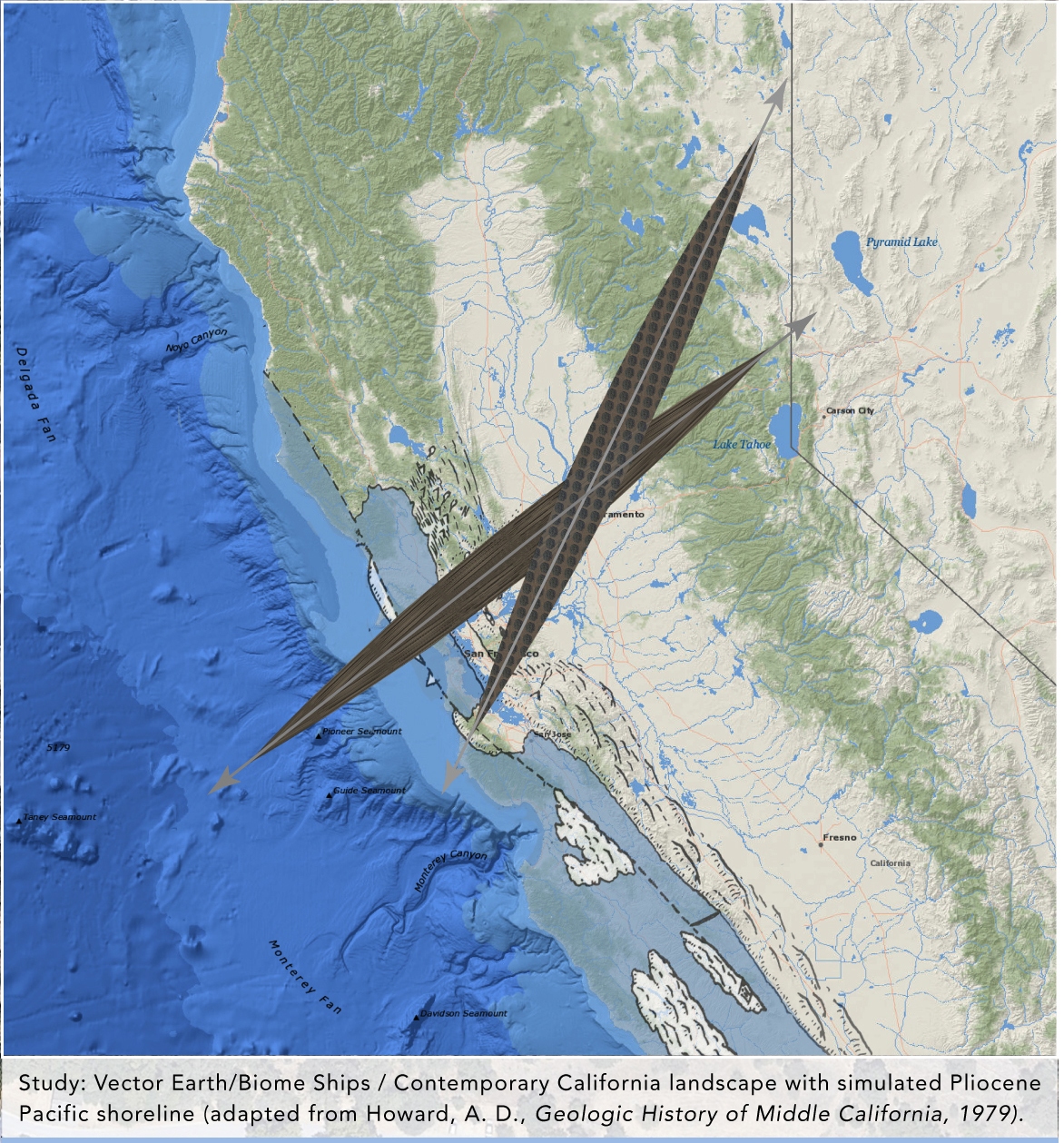
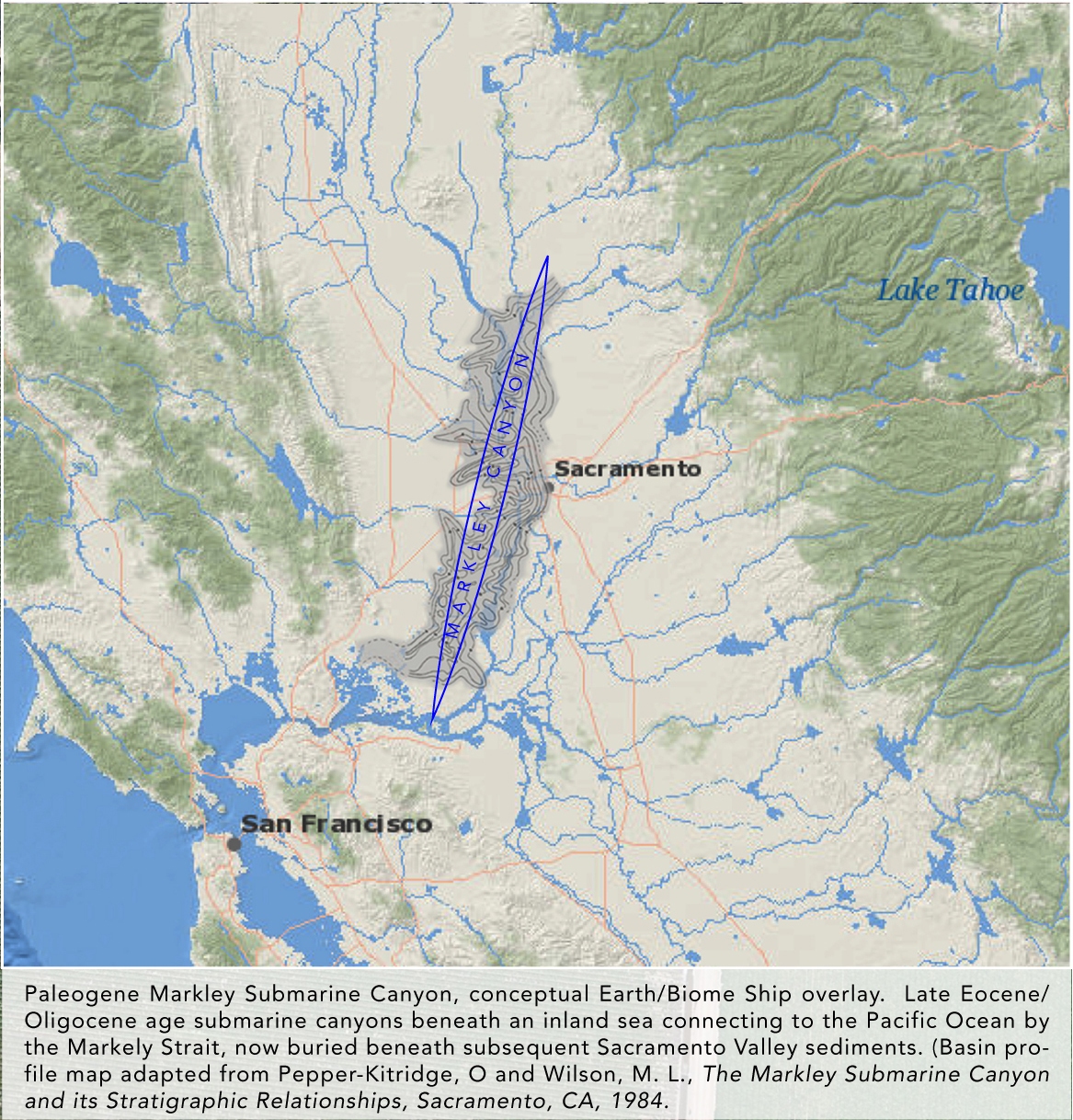
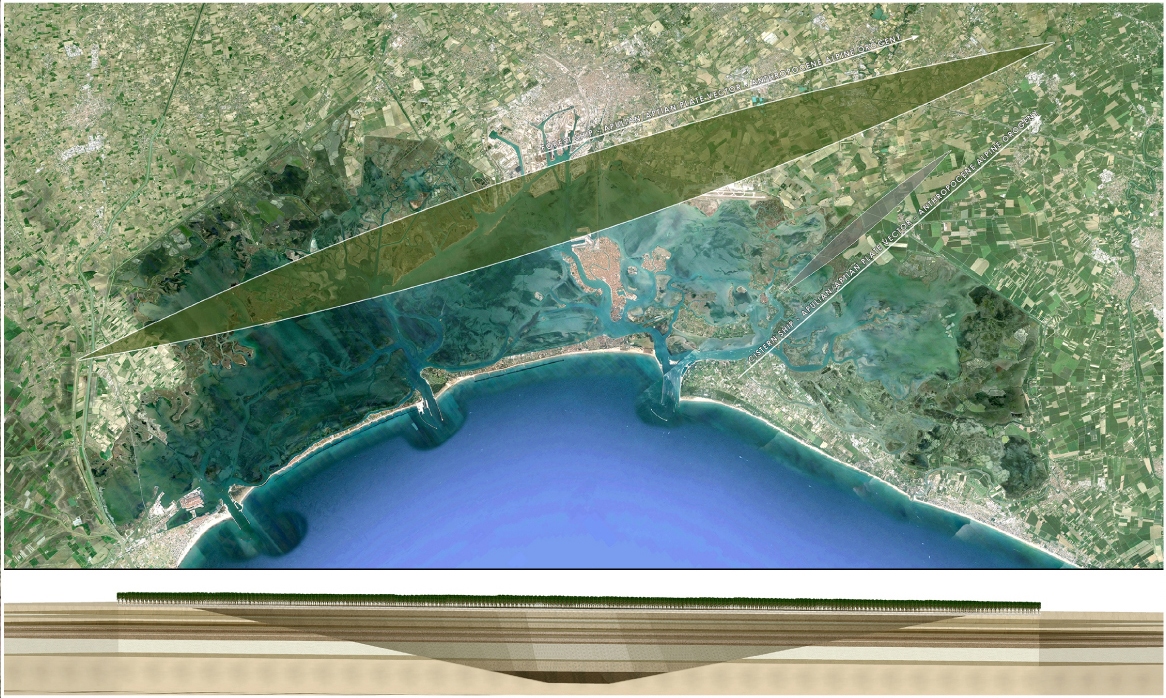

For the past 50 years, my work has been fundamentally about ecology in an expanded frame. My understanding of land, sea and atmosphere engages interrelated cycles of natural and man-made materials and processes. This world view, originating in studies of the earth sciences, was developed through an art practice of ceramics, installations and conceptual proposals that evolved ideas of site-alchemical material/historical transformations as a symbiotic merging of physical matter and living systems across geologic time – a condition of global metabolism. My practice embraces an integration of ecology, geology, ontology, self-organizing systems, energy flow and aesthetics with expanded ceramics as protagonist, engaging narratives seeking to transcend the “living/non-living” dichotomy.
John Roloff is a visual artist who works conceptually with site, process and natural systems. He is known for his ceramic works and outdoor kiln/furnace projects done from the 1970’s into the 1990’s, as well as other large-scale environmental projects, gallery installations and objects investigating geologic and natural phenomena. Based on an extensive background and ongoing research in the earth sciences, he works from geochemical and global metabolic perspectives. His work since the late 1960’s engages poetic and site-specific relationships between material, concept and performance in the domains of geology, ecology, architecture, ceramics, industry, metabolic systems and history. The ship is a central image of his work, metaphorically evoking psychological and transformative processes of the sea and land in geologic and contemporary time.
He studied geology at UC Davis, Davis, CA with Professor Eldridge Moores and others during the formative days of plate tectonics in the late-1960’s. Contemporaneous with geology he studied art with Bob Arneson and William T. Wiley, also at UC Davis. He received a master’s degree in art in 1973 from CSU Humboldt. In addition to numerous environmental, site-specific installations in the US, Canada and Europe, his work has been included in exhibitions at the Whitney Museum of American Art, UC Berkeley Museum, San Francisco Museum of Modern Art, Smithsonian Institution, Photoscene Cologne and the Venice Architectural and Art Biennials, The Snow Show in Kemi, Finland and Artlantic: wonder, Atlantic City, NJ. Art works in the public realm that explore geologic and related concepts can be found at sites such as: Yerba Buena Gardens, San Francisco, CA, University of Minnesota, Minneapolis, MN, I-5 Colonnade Park, Seattle, WA and Stanford University, Palo Alto, CA. He has received 3 artist’s visual arts fellowships from the NEA, a Guggenheim Foundation fellowship, a California Arts Council grant for visual artists and a Bernard Osher Fellowship at the Exploratorium, San Francisco, CA. He is represented by Anglim/Trimble Gallery in San Francisco and is Professor Emeritus of Sculpture/Ceramics at the San Francisco Art Institute.



